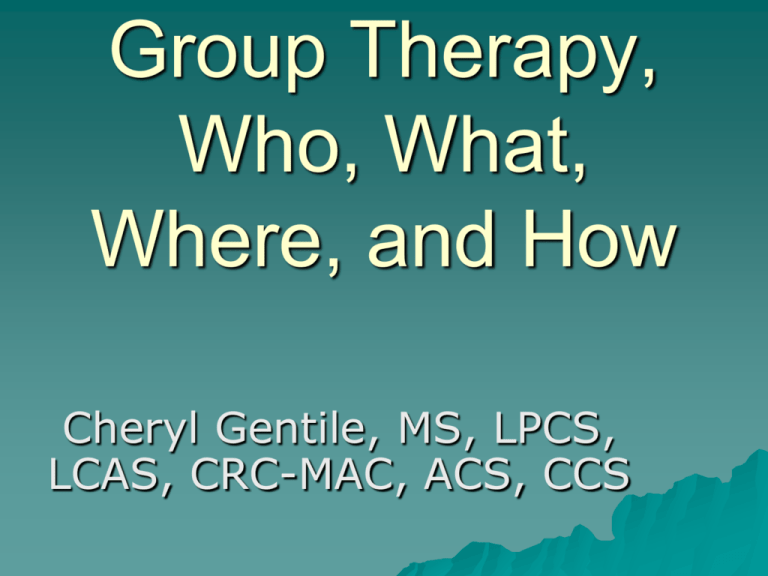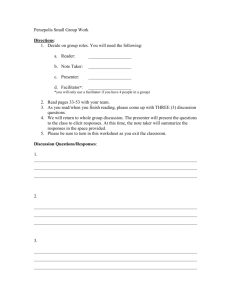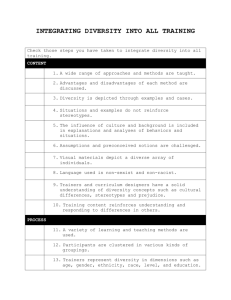Group Therapy, Who, What, Where, and How
advertisement

Group Therapy, Who, What, Where, and How Cheryl Gentile, MS, LPCS, LCAS, CRC-MAC, ACS, CCS The Advantages of Group Help members learn to cope with problems related to substance abuse by allowing them to see how others deal with similar problems Reduces the sense of isolation Witness the recovery of others Provides information about recovery Provides feedback to others Allow a single treatment professional to help a number of clients at the same time Help clients overcome past harmful experiences. Encourage, coach, support, and reinforce members as they undertake difficult or anxietyprovoking tasks. Add needed structure and discipline to the lives of people with substance use disorders, who often enter treatment with their lives in chaos. 11 Curative Factors Instillation of hope Universality Imparting information Altruism Corrective Recapitualtion of Primary Family Improved social skills Imitative behavior Interpersonal learning Cohesiveness Catharsis Existential factors Negative Attributes of Group Not for everyone Confidentiality Difficult to build trust Untrained facilitators Not enough time to meet everyone’s needs Conformity vs. peer pressure Types of Groups Psychoeducational Skills development Cognitive–behavioral Support Interpersonal process Psychoeducation Groups Role of the facilitator is to educate Targeted for the pre-contemplative and contemplative stages of change Provides information about recovery Structured with specific content Skills Development Groups Facilitator is a role model and educator Anger management Resiliency Identifying and avoiding triggers Enhance coping Relaxation techniques Structured Cognitive–Behavioral Groups Facilitator role is one of active engagement Focuses on immediate problems Promotes self-control skills to manage overwhelming emotions Is early-recovery–oriented Emphasizes structure Goal oriented Interpersonal process Groups Role of the facilitator is to monitor individual needs Early experience affects later experience. Focuses on the Now Interactions in a group setting Explores attachments Self Help Vs. Interpersonal Peer leader Voluntary No screening No theoretical approach Unlimited number No contract Professional INV or Voluntary Screening Multiple approaches 8-15 members Contractual Qualities of a Group Facilitator Confidence Knowledge Spontaneity Integrity Trust Humor Empathy Facilitator Skills Active Listening Reflecting Clarifying Summarizing Facilitating Empathizing Interpreting Questioning Linking Confronting Supporting Blocking Assessing Modeling Suggesting Initiating Evaluating Terminating Stages of Group Forming Storming Norming Performing Adjourning Placement considerations Meet with each candidate for group placement Assess the client’s level of: – interpersonal functioning – impulse control – Motivation – Stability The How Tos Introductions Setting the Norm Provide direction Facilitator acknowledges each member, and their reactions to one another Middle Stage Content, information, and feelings are expressed, and processed Non Ask verbal cues are addressed members how they are doing in group End Stage “Termination is more then the end of therapy it is an important force in the process of change……a stage in the individuals career of growth.” Yalom (1995, pp361-362)






